If you spend any time reading news online, you have probably heard about a new book called Forget the Alamo – The Rise and Fall of an American Myth.
(Who wrote it is irrelevant because all writers of that genus in this genre are interchangeable.)
The interchangeable coastal media has written a passel of reviews, and each one looks at the book less critically than a dog eyes a pile of fresh vomit.
That’s ok. I have enough criticism to make up for it. But first, let’s allow the book’s three interchangeable authors to introduce their “work” in their own words. That’s fair, right?
Here are the opening paragraphs:
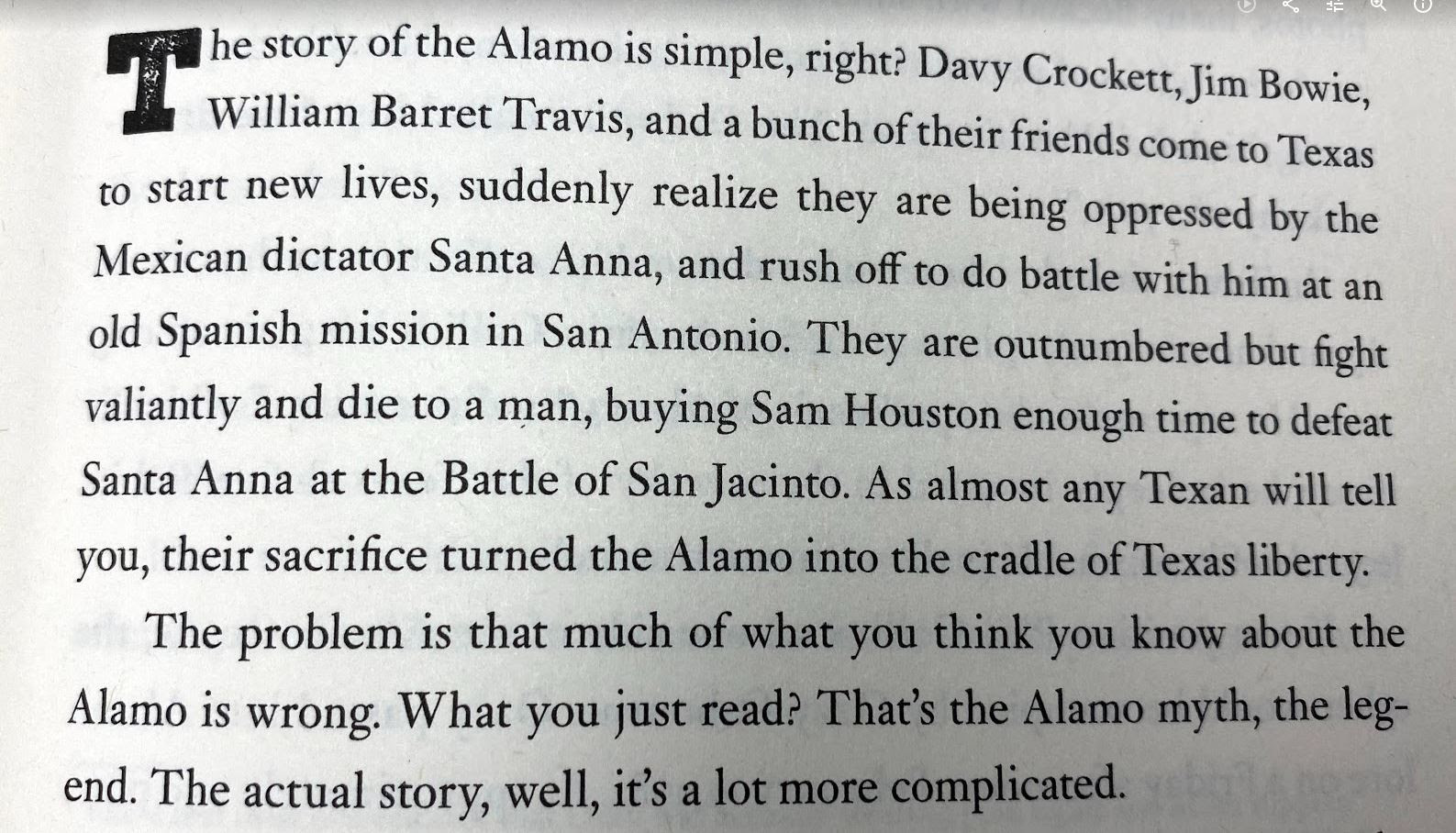
I’m guessing you recognized that first paragraph is a straw man. Instead of taking on what people actually believe about the Alamo, they set up a ludicrous hay-filled argument which they spend a few hundred pages tearing apart like flying monkeys ripping into the poor Scarecrow.
The second paragraph is the classic, “You’ve been lied to!” trope of the conspiracy theories and late-night infomercials. Pretty crafty, ain’t they?
When they get down to telling the “actual story” of the Alamo, what you get is pretty much what’s been accepted by Alamo scholars for the last fifty years, but a hefty dose of snark and some outright lies.
My experience reading the book went something like this:
Yeah… uh huh… true… okay… right… WHAT?! sure… right… true… yeah… yeah… HUH?!
It’s those WHATs and HUHs they slip in that pervert the narrative to make the Texians look like villains and to promote the idea that the Texas Revolution, and therefore the Battle of the Alamo, were primarily about slavery. (As I wrote here, that is an idea only held by idiots.)
So, let’s have a look at a few of those WHATs and HUHs.
We’ll start with pages 109 and 110. Here the authors describe the experiences of Lorenzo de Zavala, the staunch Federalista and arch enemy of Santa Anna, who would soon become the provisional Vice President of the Republic of Texas.
They say that de Zavala was shunned by white men and struggled to cope with their racism.
Here are their words:

According to chapter note 7, the source material will be found in W. S. Cleaves’ 1932 article in Southwestern Historical Quarterly titled, “Lorenzo de Zavala in Texas,” page 34 to be precise.
Below you will see an image of page 34 of that article in full, and you will note that it says the opposite of what our three interchangeable authors claim.
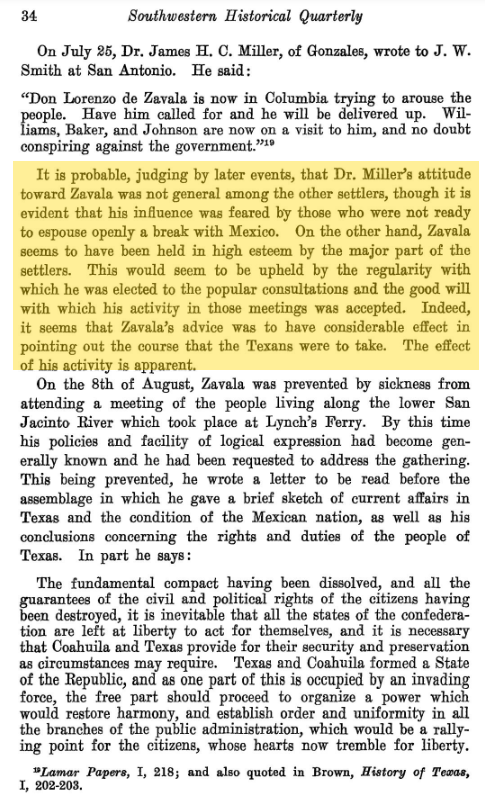
Is this an honest mistake? Are they liars? Are they just bad at their job?
You decide.
Let’s move on to something on page 141. Here they claim Texas soldiers at San Jacinto raped Mexican camp followers.
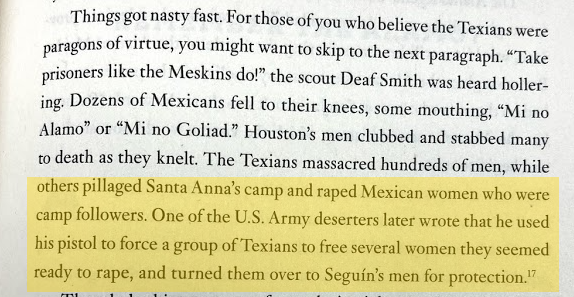
Chapter note 17 references Bill and Marjorie Walraven’s excellent Southwestern Historical Quarterly article from 2004 titled, “The Sabine Chute: The U.S. Army and the Texas Revolution.” The applicable pages are 579 and 580 in volume 107 of that journal.
Below you will find each of those pages in full, so you’ll see I’m not taking anything out of context. The relevant passages are highlighted.

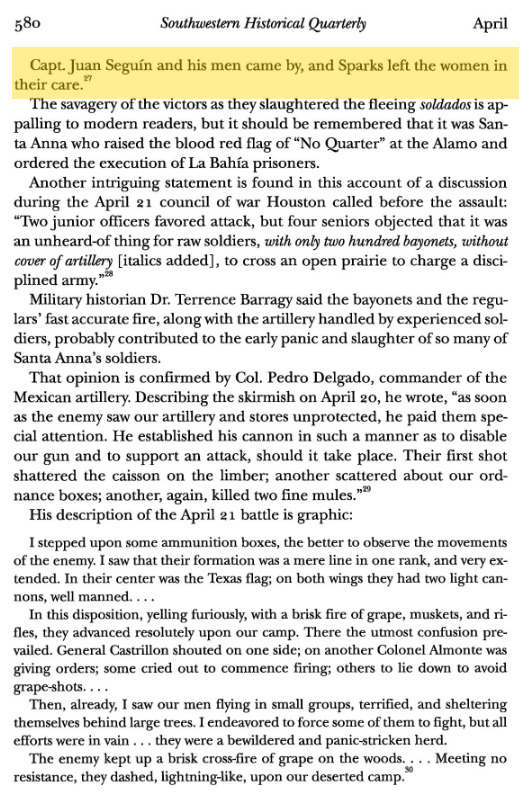
The Sparks account quoted by the Walravens is well known to all serious students of San Jacinto. As you can see, there is no mention of rape on the cited pages. (It should also be noted that Sparks was not a US Army deserter and the Walravens do not call him such. Our interchangeables are not close readers.)
I believe I’m familiar with all the known first hand accounts of what happened at the Battle of San Jacinto, both Texian and Mexican. If there is one that mentions Texas soldiers raping Mexican woman, I have not found it. And neither have these clowns.
Strike two.
How about one more?
Henderson Yoakum was the first person to write a comprehensive history of Texas. His two volume, 1158 page History of Texas was published in 1855 and was the standard for almost thirty years.
On page 150 of Forget the Alamo, our three representatives of genus interchangeabilus tell us that Yoakum cites Mexico’s abolition of slavery as a cause of the Texas Revolution.
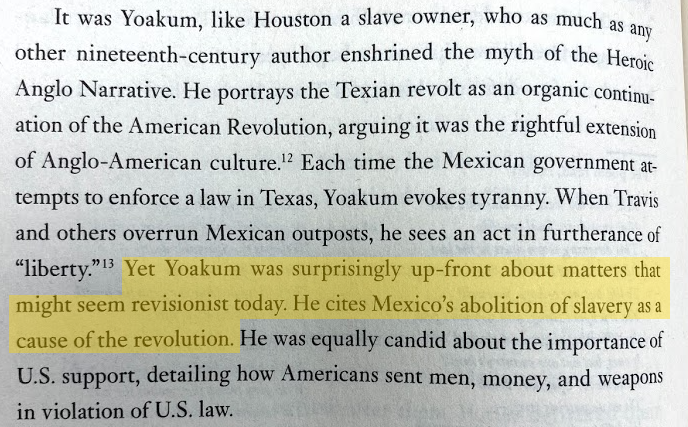
I didn’t recall that in Yoakum, and it’s a hell of a claim to leave unsourced. Fortunately the text of both volumes of Yoakum are searchable online thanks to the Portal to Texas History.
Yoakum’s writing on the reaction of Texas colonists to Mexico’s abolition of slavery is confined to the single paragraph shown below, which appears on the bottom of page 269 of volume one.

That looks like three strikes to me.
If you would like more, please read former Land Commissioner Jerry Patterson’s gutting of these scribblers. You will enjoy it.
Categories: Texas Culture, Texas Revolution, The Alamo
